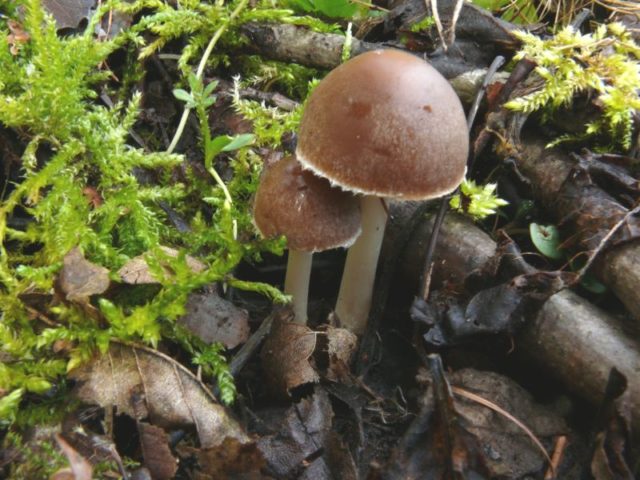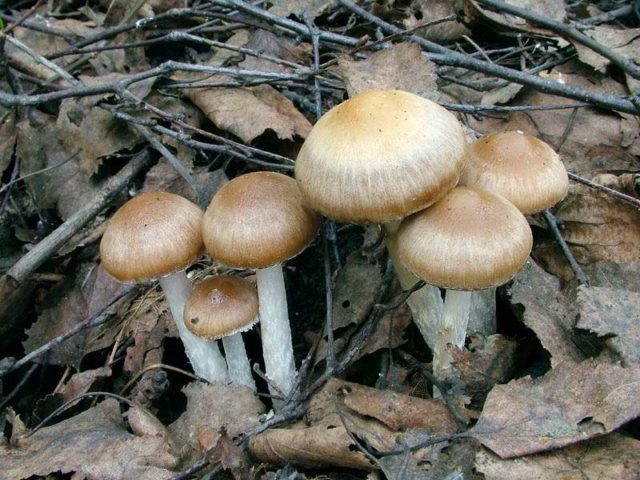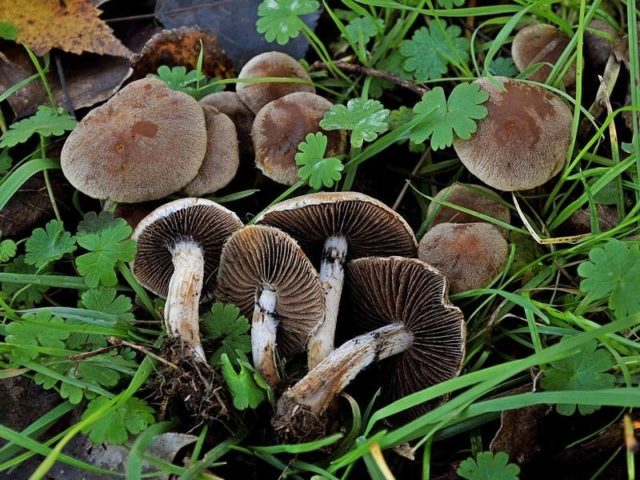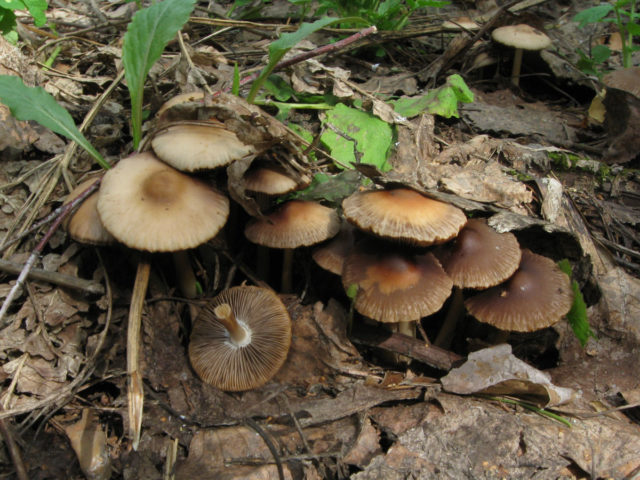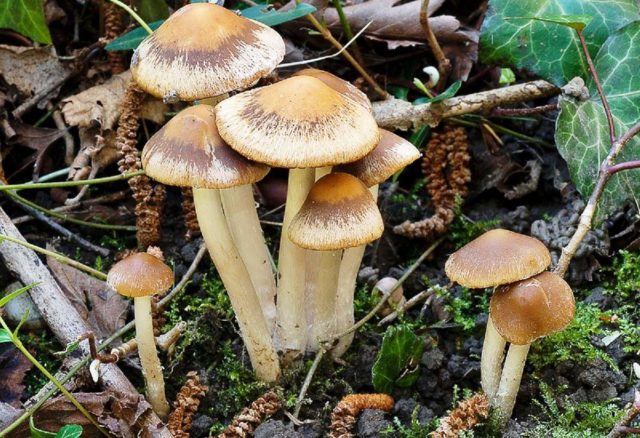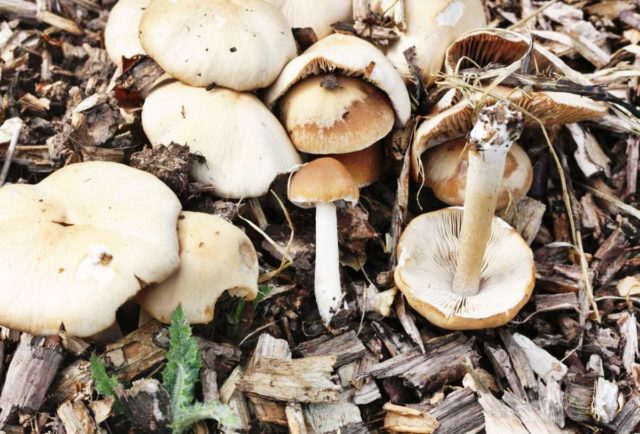Content
Psaritella gray-brown is almost unknown even to experienced lovers of quiet hunting. In most cases, mushroom pickers mistake it for a toadstool. However, it is an edible variety that occurs from early spring to late autumn.
Where do gray-brown psatirella grow
You can meet gray-brown psaritella in a deciduous forest. For growth, she chooses old stumps and decaying wood. This representative of the mushroom kingdom appears one of the very first in May, in parks and forests. The fruiting season passes in waves. Some mushroom pickers claim that it is possible to pick these mushrooms in certain regions until October.
What do gray-brown psatirella look like?
In young specimens, the cap is domed, with a diameter of 2 to 5 - 6 cm. Over time, during aging, it straightens and becomes flat, with a small tubercle in the middle. Its color is from brown to gray, depending on ripeness and weather conditions during development. The edges of the cap are fringed. As the fungus grows, the color may change towards darkening.
Psaritella gray-brown belongs to the lamellar species. The underside of young specimens is covered with intergrown thin light plates, which darken with age to a rich brown color.
The leg is thin, hollow, up to 10 cm high, no more than 6 - 8 mm in diameter. There is a thickening on the bottom. The flesh of the leg is whitish, fragile and slightly watery.
Is it possible to eat gray-brown psatirella
Biologists classify the gray-brown psaritella as an edible mushroom. Its fruiting body is free of toxins that can have a negative impact on human health. But among mushroom pickers, the opinion about the edibility of this gift of the forest is ambiguous. Some are sure that this variety is not worth collecting for food, since it looks like poisonous mushrooms. In addition, its fruiting body is thin, therefore it has no great value for consumption.
Mushroom taste
However, experts say that gray-brown psaritella has rather high gastronomic properties. When boiled, it retains a bright mushroom taste and aroma. At the same time, it is noted that the transportation and preparation of fragile fruit bodies causes difficulties.
Benefits and harm to the body
There is practically no information about the beneficial and harmful qualities of the fungus. It does not use gray-brown psaritella for commercial purposes. Therefore, no serious research has been carried out on the content of beneficial or harmful substances in the product.
False doubles
The color of the fruiting body of Psaritella gray-brown is very variable. In dry weather, it may brighten, and with age, it darkens. Therefore, it is difficult to distinguish it from other representatives of the Psaritella genus, among which there are also poisonous specimens.
Psaritella water-loving
This mushroom in shape, as well as in the size of the cap and leg, is very similar to the gray-brown look.Color may vary depending on weather conditions. In drought, the fruit body brightens, and in rainy weather, the hydrophobic cap absorbs moisture and darkens. The main difference between the species is the false ring, which is located at the top of the leg.
The water-loving psaritella grows on old stumps and fallen trees. She is very similar to the autumn mushroom, so she is sometimes mistakenly referred to as false representatives of this species.
Psaritella wadded
Another representative of the genus Psaritell, who loves to settle on the remains of coniferous trees. Most often, this variety grows in dense groups, but it can also be found in single specimens. Psaritella wadded differs in a lighter shade of the cap. But in form, it is similar to most representatives of its kind. The fungus is considered inedible, although there is no information on the content of toxins in the fruiting body.
Collection rules
Fruit bodies are cut with a knife without injuring the base and mycelium. For eating, you need to choose young representatives of the species with a domed cap. Do not collect gray-brown psaritella damaged by insects.
Fragile fruiting bodies are folded loosely in rigid baskets. Otherwise, the caps and legs can be easily damaged during transportation.
Use
Due to the lack of toxins in the composition, it is believed that psaritella can be consumed even raw. But it is recommended to boil mushrooms for a short time.
Before cooking, the fruiting bodies must be gently rinsed in water. You can pre-soak mushroom raw materials in a salty solution to rid the space between the plates from insects and sand. When soaking, the water is changed 2 - 3 times. The damaged parts of the fruit bodies are cut off.
Mushrooms are placed in an enamel bowl and filled with a small volume of water. During the cooking process, a lot of foamy liquid is released. Boil gray-brown psaritella for no more than 15 minutes. After that, the broth is drained and the mushroom mass is washed in a large amount of clean water.
Psaritella gray-brown is used to make vegetable soups, stews or sauces.
Mushrooms can be harvested for winter cooking. Fruit bodies, pre-boiled and washed, are placed in containers or bags for freezing.
Like most gifts from the forest, this species can be dried. When moisture is removed, the mushroom pulp brightens. Raw materials are dry cleaned from debris, damaged parts are cut out and crushed. A fragile mushroom can be crumbled with your hands.
Fruit bodies are dried in a vegetable dryer or an ordinary oven. In this case, the temperature should not exceed 100 ° C. It is advisable to use a ventilated cabinet. In conventional mushroom ovens, the door is left ajar.
The dried mushroom mass is ground in a coffee grinder or manually.
Conclusion
Psaritella gray-brown is rarely used for food. The nondescript appearance and difficulties in transportation make it undeservedly bypassed by mushroom pickers. It is better for beginners not to collect such an ambiguous look on their own. At the same time, it is difficult to confuse the gray-brown variety with poisonous twins.
